Eileen was warm and delightful, and had a charming thick Scottish brogue (which kept my ear working hard to catch every word). She gave us a tour of the Trust office and the archives (kept in a smaller building in back once known as the "soup kitchen" where the students were fed when it was a school), and gave me a number of items of historical interest including a vintage photo of Finzean House, where my 4x-great-grandparents had lived.
Finzean was (and continues to be) a large estate held by the Farquharson family for 16 generations now. In the 1790s, an aging Farquharson laird ("Archibald the elder") had married a young girl named Christian Spring (the sister of my 4x-great-grandmother), had a son to carry on his line ("Archibald the younger"), and then died, leaving a very young widow and a 3-year-old laird. My 4x-great-grandparents, Robert Sherrat and Isobel Spring, who had just married the same year that the laird died, moved to Finzean House to help out. Robert became the overseer of the Finzean estate (at that time, 16,000 acres in two parishes) for the next dozen years until the young laird came of age. During that time, 1797 until around 1810, the widowed Christian together with Robert and Isobel all lived at Finzean House and raised their children there. After the laird grew up, his mother remained at the house some years longer, but my 4x-great-grandparents moved to a nearby farm on the estate called Tillyfruskie, where they lived until Robert died in 1818. By then, their oldest daughter Christian (named after her aunt) had married a local boy named Robert Catanach, and they lived on a farm called Woodend, higher up the Feugh valley toward the Forest of Birse (also part of the Finzean estate). When Robert Sherrat died, his widow Isobel and her unmarried children all moved in to Woodend with the Catanachs.
All of those places still existed today in some form, as well as the Birse kirk, where Robert and Isobel had baptized all of their children, and where Christian had married the laird, baptized their son, and was buried. Eileen made a couple of phone calls and arranged some visits for me. The Birse kirk still existed, no longer used for worship, but used as a community hall, and Eileen arranged for us to meet up with a woman who had the key. Finzean House was still inhabited by a Farquharson laird, and Eileen located the laird's wife in a meeting at the estate's new Farm Shop, so she sent us down the road to catch her when she came out of the meeting. Earlier this year, the estate had opened the Farm Shop (part of creating local opportunities), which offers a delicious array of local meat and produce, and other local products (such as Duncan's of Deeside shortbread, the most melt-in-your-mouth-like-butter shortbread made in a factory at Woodend, one of the places my ancestors lived). While we were waiting for Catriona Farquharson to come out of her meeting, I discovered that the charming young woman behind the counter with the warm smile was also a Farquharson, Kate, married to the Finzean laird's younger brother Andrew. I had explained our interest in Finzean House, and asked her where she lived. Oh, we just live in a simple farm house, she replied. Which turned out to be Tillyfruskie, another place my family had lived! I asked her if she would mind if we stopped by later that day, and she said that we would be very welcome.
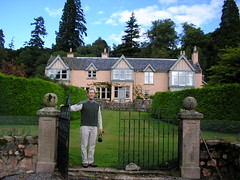 Meanwhile, Catriona Farquharson had emerged from her meeting, and we introduced ourselves to her and explained our connection and interest in Finzean House, and asked if we could come up and have a look around. She asked how long we were in town, and I said this was our only free day. As I said this, I regretted not making better arrangements in advance, realizing that we were imposing ourselves on a private family home at half past ten in the morning with no notice whatsoever. But she graciously invited us to follow her home and have a look around the gardens and the outside of the house. She had children at home waiting for breakfast and probably still in pajamas, so she apologized for not being able to invite us inside. (There we were, perfect strangers, rudely inviting ourselves over to her house without notice or introduction, and she's apologizing to us for not inviting us in! I can only hope I'd be as gracious in similar circumstances. But that's the sort of kindness we were met with all around Deeside.) We got into our cars and followed her a short ways up the road and then a longer ways down a dirt-and-gravel track until we came upon Finzean House. Beyond a wrought iron gate and a holly hedge lay the two-story estate house, looking freshly restored to its Victorian style, with an overall dusty rose colored plaster and blue-grey trim, featuring three prominent gables with decorative exposed beams and corbelling under the box windows. Several chimneys and both gabled and shed dormer windows added interest to its form. The house was set on a gradual slope, and the surrounding gardens and lawns were terraced, framed by a low stone wall and trimmed hedges.
Meanwhile, Catriona Farquharson had emerged from her meeting, and we introduced ourselves to her and explained our connection and interest in Finzean House, and asked if we could come up and have a look around. She asked how long we were in town, and I said this was our only free day. As I said this, I regretted not making better arrangements in advance, realizing that we were imposing ourselves on a private family home at half past ten in the morning with no notice whatsoever. But she graciously invited us to follow her home and have a look around the gardens and the outside of the house. She had children at home waiting for breakfast and probably still in pajamas, so she apologized for not being able to invite us inside. (There we were, perfect strangers, rudely inviting ourselves over to her house without notice or introduction, and she's apologizing to us for not inviting us in! I can only hope I'd be as gracious in similar circumstances. But that's the sort of kindness we were met with all around Deeside.) We got into our cars and followed her a short ways up the road and then a longer ways down a dirt-and-gravel track until we came upon Finzean House. Beyond a wrought iron gate and a holly hedge lay the two-story estate house, looking freshly restored to its Victorian style, with an overall dusty rose colored plaster and blue-grey trim, featuring three prominent gables with decorative exposed beams and corbelling under the box windows. Several chimneys and both gabled and shed dormer windows added interest to its form. The house was set on a gradual slope, and the surrounding gardens and lawns were terraced, framed by a low stone wall and trimmed hedges. It is unclear the precise relationship between this present-day house and the one my ancestors lived in. The house fell into disrepair in the mid 1800s, when there were a couple of "absentee lairds", before it was reinhabited and fixed up again in the late Victorian period. Much of it was destroyed in a 1954 fire, and then rebuilt, and in recent years the present Farquharsons have done much restoration work to bring it back to its Victorian form. The present form, while freshly renovated, remains faithful to the Victorian form. (The vintage photo that Eileen Bailey gave me showed a Finzean House with the same chimneys and gables.) Parts of the formal garden, particularly the holly hedge, are said to date back to Francis Farquharson, the 5th laird of Finzean, who did much to improve the estate in the mid 1700s. The Finzean estate is fairly intact as it was in my 4x-great-grandparents' time. While the Lumphanan lands have been sold off, the Farquharson family still has nearly 8000 acres of farmland, moors, and forest in Birse. It was a thrill to be in this place where my ancestors had lived.
It is unclear the precise relationship between this present-day house and the one my ancestors lived in. The house fell into disrepair in the mid 1800s, when there were a couple of "absentee lairds", before it was reinhabited and fixed up again in the late Victorian period. Much of it was destroyed in a 1954 fire, and then rebuilt, and in recent years the present Farquharsons have done much restoration work to bring it back to its Victorian form. The present form, while freshly renovated, remains faithful to the Victorian form. (The vintage photo that Eileen Bailey gave me showed a Finzean House with the same chimneys and gables.) Parts of the formal garden, particularly the holly hedge, are said to date back to Francis Farquharson, the 5th laird of Finzean, who did much to improve the estate in the mid 1700s. The Finzean estate is fairly intact as it was in my 4x-great-grandparents' time. While the Lumphanan lands have been sold off, the Farquharson family still has nearly 8000 acres of farmland, moors, and forest in Birse. It was a thrill to be in this place where my ancestors had lived.It was also great to see the remarkable tradition of stewardship in the present Farquharson family for preserving the rural character and way of life in Birse parish. They have realized that to preserve it, they must make it sustainable by developing local businesses and housing, providing opportunities for the children of the parish to stay rather than being forced to move into the city. In addition to setting up the Farm Shop this year, the Estate has sold housing sites at greatly reduced prices to enable and encourage young families to stay in the area.
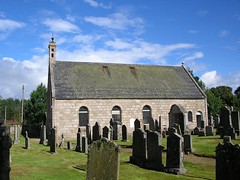 After appreciating the gardens and snapping some photos, we headed back over the hill to find the old Birse kirk, where Eileen had arranged for us to meet a Mrs. Dinnie who would open it for us. After missing a turn and doubling back, we found the place and the kindly Mrs. Dinnie patiently waiting. The church is a simple stone rectangle with a sloped roof and a small steeple, little changed on the outside since the present church was built in 1779 (and on a site where a church has stood for many centuries before that). Mrs. Dinnie was very nice and took us on a little tour on the inside. On entering the narthex, one immediately is drawn to the side, where a tall stone is displayed. Called the Crusader Stone, it stands six feet tall and the carved symbols of cross and sword can still be made out. It was discovered when the foundation of the current church was being dug out in 1779, and it is estimated to be from the 12th century.
After appreciating the gardens and snapping some photos, we headed back over the hill to find the old Birse kirk, where Eileen had arranged for us to meet a Mrs. Dinnie who would open it for us. After missing a turn and doubling back, we found the place and the kindly Mrs. Dinnie patiently waiting. The church is a simple stone rectangle with a sloped roof and a small steeple, little changed on the outside since the present church was built in 1779 (and on a site where a church has stood for many centuries before that). Mrs. Dinnie was very nice and took us on a little tour on the inside. On entering the narthex, one immediately is drawn to the side, where a tall stone is displayed. Called the Crusader Stone, it stands six feet tall and the carved symbols of cross and sword can still be made out. It was discovered when the foundation of the current church was being dug out in 1779, and it is estimated to be from the 12th century.As we entered the main part of the sanctuary, there was an aisle down the center length of the rectangle leading to the altar and pulpit, with wood pews on either side, a typical church layout as we're used to. Though Mrs. Dinnie explained to us that in my ancestors' time, the layout was perpendicular to how it is now. The pulpit had been in the middle of the long side wall, and the pews were arranged parallel to the long walls, and facing what today we consider the right side wall. Toward the back of that arrangement (i.e., the modern left side) was a prominent gallery pew where the laird and his family sat. This gallery pew was emblazoned with a Farquharson family crest, which is preserved in a plaque on the left wall today. On the right wall, near where the old pulpit would have been, is a plaque commemorating the Rev. George Smith and his father Rev. Joseph Smith, who served the parish 74 years between them. It was Rev. Joseph Smith who baptized all the children of my 4x-great-grandparents, and who married my 5x-great-aunt Christian to Archibald Farquharson. Those who have family history in the area owe a special debt of gratitude to Rev. Smith, who was especially fastidious in his record-keeping, including making lists of all the inhabitants of his parish every few years (a boon to genealogists, and something not replicated in any of the other parishes around).
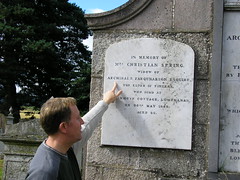 After soaking up the history of the church interior, we went back outside to the kirkyard where there were a few graves I wanted to find. This time, I did have a map of the kirkyard, but I also knew I wouldn't need it. The Farquharson enclosure is the most prominent stone in the yard. There were the graves of several of the Finzean lairds, including Archibald Farquharson the younger (my 1st cousin 5x removed), and my 5x-great-aunt Christian Spring, the widow of Archibald the elder. It was awesome to see in stone the link between my family and the Farquharsons (a connection that had been passed down in my family with much romantic distortion, and that took me a while to discover the facts of). I also wandered around the kirkyard and found other familiar names on the stones, such as Shaw Catanach, the father-in-law of my 4x-great-aunt Christian Sherrat. Mrs. Dinnie was intrigued by that, as her husband had some connection to the Catanachs, and the farm they lived on had once been a Catanach farm.
After soaking up the history of the church interior, we went back outside to the kirkyard where there were a few graves I wanted to find. This time, I did have a map of the kirkyard, but I also knew I wouldn't need it. The Farquharson enclosure is the most prominent stone in the yard. There were the graves of several of the Finzean lairds, including Archibald Farquharson the younger (my 1st cousin 5x removed), and my 5x-great-aunt Christian Spring, the widow of Archibald the elder. It was awesome to see in stone the link between my family and the Farquharsons (a connection that had been passed down in my family with much romantic distortion, and that took me a while to discover the facts of). I also wandered around the kirkyard and found other familiar names on the stones, such as Shaw Catanach, the father-in-law of my 4x-great-aunt Christian Sherrat. Mrs. Dinnie was intrigued by that, as her husband had some connection to the Catanachs, and the farm they lived on had once been a Catanach farm.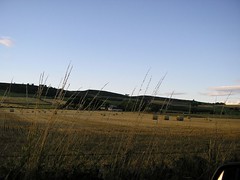 We then dashed back to Aboyne to meet our other traveling companions for an afternoon on the Castle Trail. Later, as the sun was getting low, they indulged me in a bit more family history exploration, and we paid a call to Tillyfruskie, the farm where 5x-great-grandpa Robert had spent his last ten years, and whose current resident we'd met at the farm shop. I had a very detailed map of the area that showed every farm, but the road from Banchory to Finzean was all farms, and at some point it just become a matter of looking for the third farmhouse after the last fork in the road. The farmhouse was set back a good ways from the road, in a stand of trees at the foot of a small hill, behind a large field of barley. The rows were still evident where the barley had recently been mowed, and the setting sun cast a golden glow on the round bales of barley straw in the field.
We then dashed back to Aboyne to meet our other traveling companions for an afternoon on the Castle Trail. Later, as the sun was getting low, they indulged me in a bit more family history exploration, and we paid a call to Tillyfruskie, the farm where 5x-great-grandpa Robert had spent his last ten years, and whose current resident we'd met at the farm shop. I had a very detailed map of the area that showed every farm, but the road from Banchory to Finzean was all farms, and at some point it just become a matter of looking for the third farmhouse after the last fork in the road. The farmhouse was set back a good ways from the road, in a stand of trees at the foot of a small hill, behind a large field of barley. The rows were still evident where the barley had recently been mowed, and the setting sun cast a golden glow on the round bales of barley straw in the field.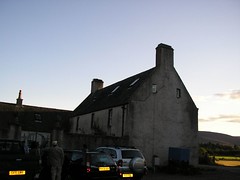 As we pulled up around the back of the stone farmhouse, we could see into an enclosed backyard through an iron gate where a little girl and younger brother were playing. "Is your Mum or Dad home?" I called to the girl. She smiled shyly and went inside, and presently a man a few years younger than me came out. "You must be Andrew Farquharson," I said, introducing myself. "Yes, Kate said you'd be coming by." He was very friendly, and told us about the house and the farm. He grows barley and raises beef cattle, the barley being sold to the distilleries for whisky, and the straw used for bedding the cattle. Andrew oversees the family estate, as did my 5x-great-grandfather. I asked if he knew whether this would have been the same house as stood back in the 1810s, and he pointed out an upper cornerstone with the date 1733 carved in it! They'd changed a fair amount on the inside, and converted what used to be an adjacent barn into a nice large kitchen and family room, and connected it to the rest of the house. But the basic structure remained, stone walls a good two feet thick is as it has been for a few centuries! Kate showed up shortly, and they showed us around the house and we had a nice visit with this warm friendly family. It was so amazing to actually see and walk in this place I had read about in musty old records, to find the same house still there, and the estate lands still being farmed much as they were six generations and two centuries ago.
As we pulled up around the back of the stone farmhouse, we could see into an enclosed backyard through an iron gate where a little girl and younger brother were playing. "Is your Mum or Dad home?" I called to the girl. She smiled shyly and went inside, and presently a man a few years younger than me came out. "You must be Andrew Farquharson," I said, introducing myself. "Yes, Kate said you'd be coming by." He was very friendly, and told us about the house and the farm. He grows barley and raises beef cattle, the barley being sold to the distilleries for whisky, and the straw used for bedding the cattle. Andrew oversees the family estate, as did my 5x-great-grandfather. I asked if he knew whether this would have been the same house as stood back in the 1810s, and he pointed out an upper cornerstone with the date 1733 carved in it! They'd changed a fair amount on the inside, and converted what used to be an adjacent barn into a nice large kitchen and family room, and connected it to the rest of the house. But the basic structure remained, stone walls a good two feet thick is as it has been for a few centuries! Kate showed up shortly, and they showed us around the house and we had a nice visit with this warm friendly family. It was so amazing to actually see and walk in this place I had read about in musty old records, to find the same house still there, and the estate lands still being farmed much as they were six generations and two centuries ago.
2 comments:
Hi Tom,
That was a really interesting piece. I assume my ancestors come from around there too, given my surname. I'd like to go there one day and see it for myself.
Andrew Birse.
Hi Tom
I am just going through my family tree and came across your page. My great grandfather was Finlay George Macpherson and Croumbie was his nephew, Croumbies .I believe his son Robert had 3 children and one of them is Katharine making her my distant cousin she married Andrew Farquharson in 1996, and I am trying to get in contact to complete our family tree what a small world
sandymac40@yahoo.ca
Alexandra GF Macpherson
Post a Comment